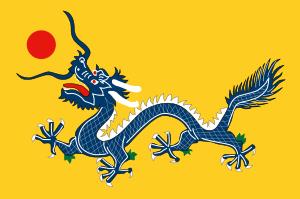The Republic of China (traditional Chinese: 中華民國; simplified Chinese: 中华民国; pinyin: Zhōnghuá Mínguó; Wade–Giles: Chung1-hua2 Min2-kuo2) is an era of Chinese history that began in 1912 and ended in 1949. It was preceded by the Qing dynasty and followed by the People's Republic of China. At the end of the Chinese Civil War, the communists gained control of the mainland, while the Kuomintang (nationalists) withdrew to Island of Taiwan and some minor outlying islands where the ROC government still retains the governing power there as present day Taiwan. The republic's first president, Sun Yat-sen, served only briefly. His party, then led by Song Jiaoren, won a parliamentary election held in December 1912. However, army leaders of the Beiyang clique, led by President Yuan Shikai, retained control of the central government. After Yuan's death in 1916, local military leaders, or warlords, asserted autonomy.In 1925, the KMT established a rival government, referred to as Nationalist China, in the southern city of Canton (Guangzhou). The economy of the North, overtaxed to support warlord adventurism, collapsed in 1927–28. In 1928, Chiang Kai-shek, who became KMT leader after Sun's death, defeated the warlord armies in the Northern Expedition. Chiang's National Revolutionary Army was armed by the Soviet Union and was advised by Mikhail Borodin. The Beiyang army was backed by Japan. Once Chiang established a unified central government in Nanjing, he cut his ties with the communists and expelled them from the KMT.There was industrialization and modernization, but also conflict between the Nationalist government in Nanjing, the Communist Party of China, remnant warlords, and the Empire of Japan. Nation-building took a backseat to war with Japan when the Japanese imperialists launched a full-scale invasion of China in 1937. During the prolonged large-scale war that rapidly spread across China, Japan invaded and occupied coastal areas and cut off China's access to seaports, while the KMT government retreated from Nanjing first to Wuhan, then to Chongqing. While the war in China, which became part of the Pacific War, raged on, the Burma Road, and later the Ledo Road, were built to allow US "lend-lease" aid to reach the Chinese army in Burma. The Nationalists' Y Force drove back the Japanese in Yunnan during a May–June 1944 offensive, but otherwise military results were disappointing. With the Japanese unconditional surrender in 1945, the Allies had finally achieved total victory, but the Cold War between the U.S. and Soviet Union led to renewed fighting between the KMT and the communists. In 1947, the Constitution of the Republic of China replaced the Organic Law of 1928 as the country's fundamental law. In 1949, the Communists established the People's Republic of China, overthrowing the Nationalists on the mainland, who retreated to Taiwan, and despite its vastly reduced territory, the Nationalist government continued to be recognized as the government of China by non-Communist states well into the 1970s.

Año de disolución
1949
Fecha de fundación
1912-01-01
Año de fundación
1912



Kommentieren
0